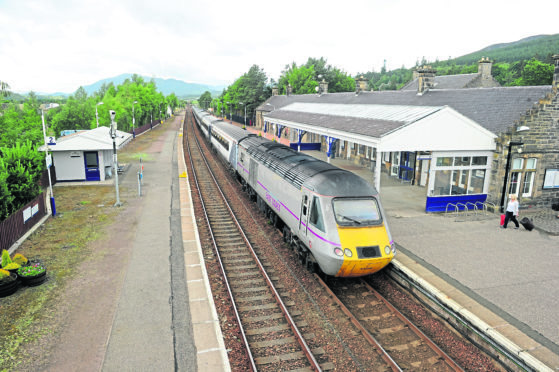Rail campaigners have accused the Scottish Government of “broken promises” on cutting train journey times between the Highlands and the Central Belt.
They also claim the Highland Main Line between Inverness and Perth is playing second fiddle to the £3 billion upgrade of the parallel A9 road.
Transport alliance Transform Scotland said the Scottish Government had failed to deliver on a pledge a decade ago to slash train journey times between Inverness and the Central Belt by 35 minutes.
Paul Tetlaw, of Transform Scotland, said: “In 2008, then First Minister Alex Salmond said that within four years the rail journey time would be cut to two hours forty-five minutes, but a decade later it remains on average around three and a half hours – yet A9 journeys are getting faster and faster as road dualling advances.
“The public were told that there would be additional rail passing loops and double-tracking, but all that is being delivered is resignalling of two crossing loops.
“Hourly passenger trains and an average journey time saving of 10 minutes are promised but with no additional track it’s highly likely we’ll see more delays and cancellations as more trains are squeezed onto the single track railway.”
He added: “Lessons need to be learned from the Borders Railway where de-scoping has created long single track sections which has led to poor performance.
“That’s the nature of a single track railway. The Scottish Government now needs to deliver on its promises with serious investment made in the railway to ensure there is a level playing field between road and rail.”
Ian Budd from rail campaign group, the Friends of the Far North Line, said: “The Highland Main Line is key to the whole regional rail network.
“Slow journey times and unreliability between Perth and Inverness have a knock-on impact on connecting trains to the Far North Line, Kyle and Elgin, and discourage people from switching from car to train.
“Rail travellers are entitled to see the Scottish Government deliver on its manifesto promises and make the step-change improvements which Alex Salmond announced 10 years ago.”
And David Spaven, from the Rail Freight Group, added: “Everyone wants to see fewer 44-tonne trucks on the A9, but the current very limited upgrade to the Highland Main Line offers little or nothing for rail freight.
“Indeed the worry now is that rather than freight shifting from road to rail – the Scottish Government’s policy objective – we will see the loss of existing rail traffics, as the A9 gets faster and the single-track railway becomes increasingly congested.
“That’s economic and environmental madness. We need longer crossing loops, so that freight trains 40% longer than at present can compete much more effectively with road hauliers.”
Scottish Government says it is “delivering” on improving journey times
The Scottish Government insisted it was improving services to the Highlands.
A spokeswoman said: “Work is progressing on enhancements on the Aberdeen to Inverness line paving the way for faster journeys, more frequent services and the introduction of a fleet of High Speed Trains.
“Phase two of the Highland Main Line programme is well underway and aims to deliver an hourly service between Inverness and Perth (continuing to Glasgow or Edinburgh), further journey time reductions of around 10 minutes, and more efficient freight operations by Spring 2019.
She added: “With just under £8 billion invested since 2007, this government has a proven track record of growing Scotland’s railways.
“We returned services to the Borders for the first time in nearly 50 years, re-opened the Stirling-Alloa-Kincardine line, and are now operating the revitalised Airdrie-Bathgate line and its new stations.
“Our on-going future investment is truly transforming the rail network and giving passengers and freight users across rural and urban Scotland the best railway they’ve ever had.”
But she warned: “While we remain committed to encouraging greater use of rail, the UK Government has unilaterally moved away from the original devolved settlement agreed.
“The funding provided for 2019-2024 falls at least £460 million short of early industry estimates of costs to deliver the improvements required to meet forecast future demand for services.
“This means our future investment decisions will need to reflect the financial climate we are faced with as a consequence of decisions taken by the UK Government.”
